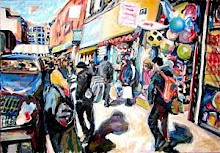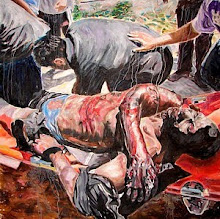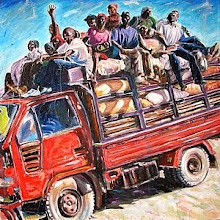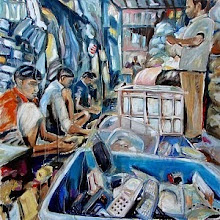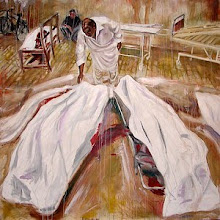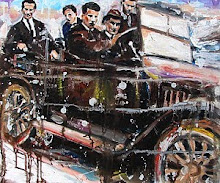Sometimes I see art as a kind of scientific research - experimenting with the same idea over and over again i.e. the cityscape. And rather than being boring it gets more interesting, a visual exploration, a way of seeing. The changes or differences are more subtle but the viewer can see them. What also happens is that you create a world i.e. the picture stops being a picture and suddenly becomes 3 dimensional like you are looking through a window, or a kind of periscope allowing you to look over the wall and turn around to see what is going on. In this way the life of the city can be observed, and so we move a long way from the 'picture' towards the realm of the documentary film.
A comment on my Dublin cityscapes from a writer living in China:
"I get to know more from the city from your works. It reminds me those Cuban paintings about those old cars and old buildings. I also noticed you like the color blue. Is that because the sunlight in Dublin is not very strong so it gives everything there a bit touch of blue?"
In a way the more local you become the more global you become. Think of a particular famous cheese in Italy or wine in France. We, the world, think it is brilliant not because it is global, but because we see it as so local. If art is about 'anything' then it becomes subject to cosmopolitan strictures which in turn becomes like international airports - they all look the same.
Dublin is near me, I grew up here. I know it well. It contains the endeavors of many Irish people through the centuries. Every local has global implications because of common or shared human experience.
Does the artist need to stay in one place where s/he is born to produce artworks?
James Joyce, for example, lived in Trieste, Italy and Zürich in Switzerland most of his life yet he wrote mainly about Dublin in his major novels written outside Dublin, Ulysses and Finnegans Wake.
Joyce wrote -
'The image, it is clear, must be set between the mind or senses of the artist himself and the mind or senses of others. If you bear this in memory you will see that art necessarily divides itself into three forms progressing from one to the next. These forms are: the lyrical form, the form wherein the artist presents his image in immediate relation to himself; the epical form, the form wherein he presents his image in mediate relation to himself and to others; the dramatic form, the form wherein he presents his image in immediate relation to others.'
[James Joyce A Portrait of the Artist as a Young Man]
According to Joyce, art that is basically self-observation fits into 'artist presents his image in immediate relation to himself'. This would be the first stage of Joyce's model. He believes you mature to then presenting yourself in relation to others, and then to basically standing above your art as a commentator in an objective sense where you subtract yourself yet leaving an imprint of yourself in the way that you re-present the world instead. A Joycean novel is Joycean by its style of writing even though it is based on his experience of Dublin. He is not in it, but everywhere in it at the same time. Maybe this is true art. He wrote ' “I want to give a picture of Dublin so complete that if the city one day suddenly disappeared from the Earth, it could be reconstructed out of my book.”
But if you take the documentary model then you could live abroad and be an observer of life in Spain for example without upsetting that idea too much. Again human experience is much the same everywhere.
For example the artist Doménicos Theotokópoulos, El Greco ("The Greek", 1541 – April 7 1614).
'El Greco was born in Crete, which was at that time part of the Republic of Venice, and the centre of Post-Byzantine art. He trained and became a master within that tradition before travelling at age 26 to Venice, as other Greek artists had done. In 1570 he moved to Rome, where he opened a workshop and executed a series of works. During his stay in Italy, El Greco enriched his style with elements of Mannerism and of the Venetian Renaissance. In 1577 he moved to Toledo, Spain, where he lived and worked until his death. [...] Modern scholarly research emphasizes the importance of Toledo for the complete development of El Greco's mature style and stresses the painter's ability to adjust his style in accordance with his surroundings. Harold Wethey asserts that "although Greek by descent and Italian by artistic preparation, the artist became so immersed in the religious environment of Spain that he became the most vital visual representative of Spanish mysticism". ' [http://en.wikipedia.org/wiki/El_Greco]
Does the content by itself give my artwork a distinctive style?
The problem for me regarding most art is that style is predominant and not content. This like citing the right bands you like to be allowed to join a band so that you will continue producing more and more of that same style. Art for art's sake has become style for style's sake. Great songwriters write about life around them, style comes second.
When I thought back through my work back to my college work I realised that trying to get movement into a single fixed 2D image has been a consistent feature.
Maybe there is something psychological there that the Fauvists and the Expressionists also tried to tap into.
There are also elements that are abstracted that have a different appeal, evoking an atmosphere rather than the real, like Rauschenberg's mixture of pure mark-making and screened images.
What ever it is, it seems to be a way of looking at things rather than the specific content itself.
I have always tried to make art that related to people - social, cultural, psychological, political and historical. Tying the two - content and form - together has been the challenge. I have endeavored to re-present what is all around us but we don't see or are tired of looking at, in an interesting way to inspire a new interest and awareness of its importance in our lives. To re-create that awareness we have of something that we only seem to get when we are very far from it or it is gone forever.
Wednesday, July 23, 2008
Subscribe to:
Posts (Atom)
